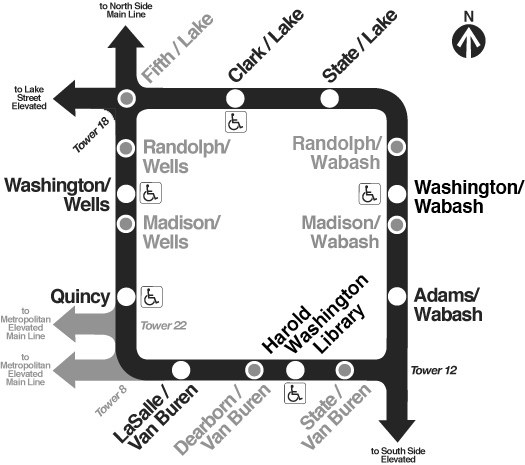|
|
|
|
Loop Elevated

|
|||||||||||||||
Legend:
Click on a station name or tower to see that location's profile (where available) |
|
|
|
|
Loop Elevated

|
|||||||||||||||
Legend:
Click on a station name or tower to see that location's profile (where available) |
Service Notes:
Brief Description:
The need for a common downtown terminal for the various elevated lines, each of which operated for years to independent terminals on the fringe of downtown, was realized before the first company even began service. The task would not be simple however. The companies had two choices and both had serious downfalls. The first option was to build the extensions and terminal on private property, but land values downtown were high, making this prohibitively expensive. The second option was to build over public streets, but this would require the consent of the majority of property owners as per the Cities & Villages Act and most regarded the prospect of an elevated line over their commercial property less than inviting.
A depressed economy and opposition from property owners squelched all previous plans for such a common terminal. It took a special man of singular talent and reputation to tackle the seemingly impossible task of united the elevateds in the single downtown terminal: businessman, financier, and traction magnate Charles Tyson Yerkes. At one point, Yerkes owned more than half of the private "L" companies (as well as 2/3 of the street railway system) and was responsible for much of the development of the system that can still be seen today. This colorful character was a shrewd businessman who was hailed by his allies and reviled by his critics. There was a long-standing bitter distrust and dislike between Yerkes and the City of Chicago, both in its citizens and its elected officials, especially Mayor Carter Harrison. Yerkes also exercised great power, both politically and financially, and had the ability to get things done, even if his improvements ended up being turned around to cast him as a typical robber baron (which, to a great extent, he was). Once he obtained the necessary consent signatures and franchises, Yerkes lost little time in beginning construction on each leg of the Loop.
The Loop opened in stages, as it was completed. The first section opened on the Lake Street between Market Street and Wabash Avenue on September 22, 1895. The Wabash leg south to Adams/Wabash station was placed in service November 8, 1896, with the Loop now forming an 'L' shape (no pun intended). Trains operated bi-directionally using right-hand running during this period. The formal opening of the entire Loop occurred October 3, 1897, when the bi-directional, left-handed Loop operating plan described above went into effect. The Lake Street was the first to use the entire quadrangle. The Met followed suit on October 11th. The South Side joined them on October 18th (the only company to use steam on the Loop, albeit briefly) and the Northwestern came as soon as they began regular revenue service on May 31, 1900.
As can be imagined, the Loop offered the citizens of Chicago advantages they'd never even remotely had access to before. Workers, shoppers and cross-town travelers could now be deposited directly into the central business district or change to another line's train without walking anywhere. The public was quick to take advantage of the new facilities, as all companies had significant ridership gains after the Loop's completion. The Metropolitan's, for instance, went from 40,000 to 60,000; an increase of 50%.
Because each of the elevated companies was separate and had no operating or transfer agreements, there was no free interchange of passengers between lines, even though they shared the same track and stations in the Loop. As such, each station was run as if it were four separate facilities under one roof. On the platforms, there was literally a barrier separating it into two distinct spaces and inside the station houses, there were two ticket agents and separate doors onto each half of the platform. On the Inner Loop, Metropolitan trains stopped at the forward berth, while South Side trains used the rear berth. On the Outer loop, Lake Street trains used the rear berth and the forward half was reserved for Northwestern trains upon the inauguration of their services.
Important Dates:
|
|
This Chicago-L.org article is a stub. It will be expanded in the future as resources allow. |
.
|
|